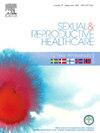Work motivation among midwives in medium-sized labour wards in Denmark – An interview study
IF 1.7
3区 医学
Q3 PUBLIC, ENVIRONMENTAL & OCCUPATIONAL HEALTH
引用次数: 0
Abstract
Introduction
Midwives are essential in securing high-quality maternity care. Despite several calls to action to curb the attrition rates of midwives, it is a continuing worldwide problem. Little is known about midwiveś work motivation, and understanding this can be key to improving well-being among midwives and thus lowering attrition rates. This study specifically explored midwiveś work-life from a salutogenic perspective focusing on aspects contributing to work motivation rather reasons behind resignation rates.
Objective
To explore midwives’ experiences and perceptions of work motivation from a salutogenic perspective.
Methods
A qualitative study was conducted with 15 female midwives working in two medium-sized labor wards (approximately 1600 childbirths annually). Participants were interviewed between December 2023 and April 2024. Data was synthesized using Reflexive Thematic Analysis.
Results
The analyses resulted in three themes: labor ward size, work-life balance and recognition. Participants elaborated on how workplace size, supportive relationships, self-awareness in work practice, and recognition from patients, peers, and management were key to work motivation. Notably, one of the labor wards had a significantly high proportion of midwives with over 15 years of experience.
Conclusion
By exploring midwives’ experiences through a salutogenic lens, this study highlights key aspects that foster work motivation and professional well-being. Key motivators included manageable ward size, supportive relationships, work-life balance, and recognition from patients, colleagues, and leadership. Notably, a labor ward with a high proportion of experienced midwives exemplified how these factors can foster long-term engagement. Future research could implement different strategies to test how they improve midwives’ motivation.
丹麦中型产房助产士的工作动机——一项访谈研究
助产士对于确保高质量的产妇护理至关重要。尽管有人呼吁采取行动遏制助产士的流失率,但这是一个持续存在的全球性问题。人们对助产士的工作动机知之甚少,了解这一点可能是改善助产士幸福感的关键,从而降低流失率。本研究特别从健康的角度探讨了midwiveva的工作-生活,重点关注有助于工作动机的方面,而不是辞职率背后的原因。目的从健康学的角度探讨助产士对工作动机的感受和体会。方法对两个中型产房(年分娩约1600例)的15名女助产士进行定性研究。参与者在2023年12月至2024年4月期间接受了采访。数据采用自反性主题分析进行综合。结果分析得出三个主题:劳动病房规模、工作生活平衡和认可。参与者详细阐述了工作场所的规模、相互支持的关系、工作实践中的自我意识、患者、同事和管理层的认可是工作动机的关键。值得注意的是,其中一个产房拥有超过15年经验的助产士的比例非常高。结论:本研究从健康角度探讨助产士的经验,强调了促进工作动机和职业幸福感的关键方面。主要的激励因素包括可管理的病房规模、支持性关系、工作与生活的平衡以及患者、同事和领导的认可。值得注意的是,一个有高比例经验丰富的助产士的分娩病房证明了这些因素如何能够促进长期参与。未来的研究可以实施不同的策略来测试它们如何提高助产士的积极性。
本文章由计算机程序翻译,如有差异,请以英文原文为准。
求助全文
约1分钟内获得全文
求助全文
来源期刊

Sexual & Reproductive Healthcare
PUBLIC, ENVIRONMENTAL & OCCUPATIONAL HEALTH-
CiteScore
2.70
自引率
5.60%
发文量
73
审稿时长
45 days
 求助内容:
求助内容: 应助结果提醒方式:
应助结果提醒方式:


